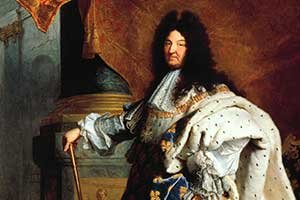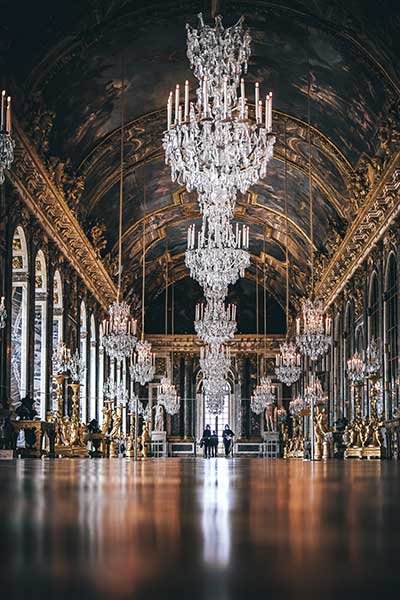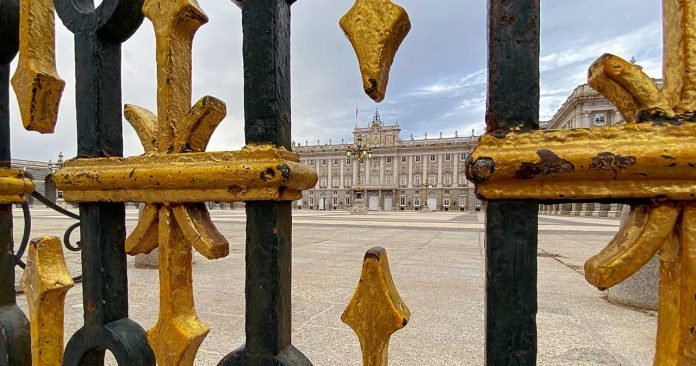Despite the winds of change sweeping across centuries, the Palace of Versailles stands in all its majestic splendor, unruffled and timeless. It remains a testament to the opulence of the French monarchy, mirroring an epoch when France was the beacon of European civilization. Steeped in historical significance and architectural magnificence, the Palace of Versailles is indeed a fascinating confluence of art, power, and history. It truly embodies the saying: ‘To visit Versailles is to walk in the footsteps of giants.’
Versailles is a commune in the department of the Yvelines, Île-de-France, renowned worldwide for the Château de Versailles and the gardens of Versailles, designated UNESCO World Heritage Sites
A Royal Welcome
The Palace of Versailles, an emblem of French grandeur, is a resplendent masterpiece where history breathes through each gilded sculpture and opulent room. As one steps onto the cobblestone pathways, one is instantly transported to a bygone era, echoing the fascinating tales of French royalty.
The Genesis of Grandeur
Humble Beginnings to Royal Residence
Versailles began its life as a modest hunting lodge for King Louis XIII. Located in the rural countryside, it was initially a place where the French king could retreat and indulge in his love of hunting. In 1624, Louis XIII decided to expand the hunting lodge into a more substantial chateau, and the transformation of Versailles began.

The Sun King’s Vision
Louis XIV, also known as the ‘Sun King’, succeeded his father, Louis XIII. Envisioning a home that would embody his authority, magnificence, and divine right to rule, Louis XIV initiated one of the most extensive construction projects of his time to transform the existing chateau into the grand Palace of Versailles.
He hired the best talents of the age – architect Louis Le Vau, painter Charles Le Brun, and landscape architect André Le Nôtre – to work on this monumental project. Together, they turned the once modest hunting lodge into a splendid and grandiose palace, surrounded by immaculately designed gardens and fountains. The Hall of Mirrors, a grand and opulent gallery where the king could receive guests, became one of the palace’s most iconic rooms. Its gilt-edged adornments and shimmering marbles epitomized the Sun King’s love for grandeur.
A Symbol of Absolute Power and Control
Louis XIV, known for his taste in opulence, moved the royal court to Versailles in 1682. This was not just an aesthetic decision, but a political one. By relocating the court and government to Versailles, the Sun King could keep the nobility under his watchful eye, thereby centralizing his power and reducing the influence of Parisian elites. Versailles became a symbol of the absolute authority that Louis XIV held over France.
The Gardens of Versailles
Just as important as the palace itself were the extensive Gardens of Versailles, designed by André Le Nôtre. Comprising meticulously laid out flower beds, grand fountains, classical statues, and intricate geometric designs, the gardens were just as much a statement of the Sun King’s power as the palace. The scale and ambition of the gardens were unprecedented, meant to demonstrate the King’s command over nature itself.
The Decline of a Symbol
For all its grandeur, the palace also played a role in the eventual downfall of the French monarchy. As a symbol of royal excess and extravagance at a time when the French populace was often struggling, the palace incited resentment and anger among the people. The last royal resident of Versailles was Louis XVI, who was forced to leave the palace in 1789 at the start of the French Revolution. The Palace of Versailles thus stands not only as a testament to the grandeur of the French monarchy but also as a symbol of the excess that led to its downfall.
Versailles Today
Now, the Palace of Versailles is one of the most visited historical sites in the world. It is a UNESCO World Heritage site and serves as a powerful and poignant reminder of the opulence, artistry, and political cunning of France’s Ancien Régime. It has been repurposed as a museum, allowing visitors from around the world to glimpse the majesty that once defined French royalty.
Versailles: A Beacon of Baroque Architecture
The architecture of Versailles, heavily influenced by the Baroque style, was groundbreaking in its scale and opulence. Characterized by its grandeur, drama, and contrast, Baroque architecture was the perfect style to embody the splendor and power of the French monarchy.
French and Italian Influences
While rooted in the classic French tradition, Versailles also took inspiration from Italian Baroque architecture. This harmonious blend is seen in the intricate details and lavish ornamentation of the exterior – grand columns, elaborate carvings, and intricate sculptures. The façade of Versailles showcases grandiosity, using scale and ornamentation to visually represent the grandeur of the monarchy.
The Splendor Within: Unraveling the Interior Majesty
Every room within the Palace of Versailles is meticulously designed, with no expense spared in the pursuit of luxury and beauty. From the marble courts to the gold-adorned salons, each element was carefully curated.

Artistic Narratives
Each room tells a story, often depicted through the paintings, frescoes, and tapestries that adorn the walls. These works often portrayed the king in a mythological context, aligning him with gods and highlighting his divine right to rule. They also depicted significant events in the history of the reign, creating a narrative of strength, wisdom, and benevolent rule.
The Hall of Mirrors: Where Reflections Tell Stories
A Masterpiece of Baroque Design
The Hall of Mirrors is the epitome of Baroque style within the palace. Designed by architect Jules Hardouin-Mansart and decorated by artist Charles Le Brun, the hall is an exemplary blend of architecture and artistry. The grand chandeliers, gilded statues, and intricate ceiling paintings combine to create an atmosphere of absolute opulence.
Political and Diplomatic Stage
More than a breathtaking gallery, the Hall of Mirrors also served a practical purpose as the location for important court ceremonies and diplomatic receptions. It was here that the Treaty of Versailles was signed in 1919, ending World War I.
The Royal Apartments: Living Lavishly
The King’s Apartments
Designed to impress and intimidate visitors, the King’s apartments were the epitome of opulence. The seven grand salons, each named after a celestial body in homage to the Sun King, were lavishly decorated with intricate frescoes, ornate furniture, and precious materials.
The Queen’s Apartments
Equally grand but more private, the Queen’s apartments provided a more intimate space for the queen and her closest attendants. The rooms, which mirrored those of the King’s apartments, featured rich tapestries, elaborate paintings, and luxurious furnishings.
A Peek into Monarchial Life
These apartments provide modern visitors with a glimpse into the extravagant lifestyle of the French monarchs. They were not merely residences but carefully staged settings where the rituals of daily life were performed before an audience of courtiers, emphasizing the monarch’s role as the center of France’s political and cultural life.
In summary, the Palace of Versailles stands as one of the finest examples of Baroque architecture, embodying the ideals of grandeur, drama, and opulence that were central to the French monarchy. Each room within this expansive palace complex tells a story, reflecting not only the lavish lifestyle of the monarchs but also the calculated image they aimed to project to the world.
Verdant Majesty: Exploring the Gardens of Versailles

The Gardens of Versailles are an integral part of the grand vision of Louis XIV and were designed to be as impressive as the palace itself. They are a testament to the ingenuity and vision of André Le Nôtre, the principal landscape architect.
Geometric Precision and Symmetry
The gardens are a perfect example of the French formal garden style, characterized by its geometric shapes, symmetry, and meticulous planning. The layout is designed along a central axis, with pathways and groves arranged in precise geometric patterns, creating a sense of harmony and order that mirrors the absolute control of the Sun King.
Majestic Fountains and Sculptures
Scattered throughout the gardens are over fifty fountains, each with its unique design and theme, often drawn from classical mythology. The sculptures that accompany these fountains are equally magnificent, fashioned by some of the greatest artists of the time.
The Grand Canal
One of the most iconic features of the gardens is the Grand Canal, a vast, cross-shaped body of water where the court would sometimes hold celebrations, including mock naval battles. It also served as a reflective surface, capturing and enhancing the grandeur of the palace.
The Orangerie: A Citrusy Surprise
An Oasis of Fragrance and Color
Built by Jules Hardouin-Mansart between 1684 and 1686, the Orangerie at Versailles is situated beneath the palace’s Parterre du Midi. It is a place where, amidst the grandeur and formality of Versailles, visitors can find a different kind of enchantment. The Orangerie houses a stunning collection of over a thousand trees, including orange, lemon, pomegranate, and olive trees.
Architectural Marvel
The Orangerie itself is an architectural marvel, with a vaulted ceiling and large, arched windows that allow sunlight to drench the citrus trees, even in winter. The design ensures that these delicate trees, native to warmer climates, can thrive year-round in the temperate French climate.
A Place of Tranquil Contemplation
The Orangerie offers a serene and intimate atmosphere, in contrast to the grand expanses of the rest of the gardens. Amidst the fragrance of blossoming citrus trees, visitors are transported to a different world, one of calm and contemplation. The space was designed not only to house the King’s prized citrus collection but to serve as a peaceful retreat from the rigors of court life.
Seasonal Spectacle
During the summer months, the trees are moved outside, and the Orangerie’s parterres are filled with a vibrant display of flowers, creating a colorful and aromatic spectacle that complements the grandeur of the palace and gardens.
In summary, the Gardens of Versailles, designed with meticulous attention to symmetry and order, are themselves a masterpiece, reflecting the grand vision of Louis XIV and the skill of André Le Nôtre. The Orangerie, in particular, stands as a jewel within this vast, verdant setting, offering visitors a place of serene beauty amidst the overarching majesty of Versailles.
Visit Official Palace of Versailles Website


















